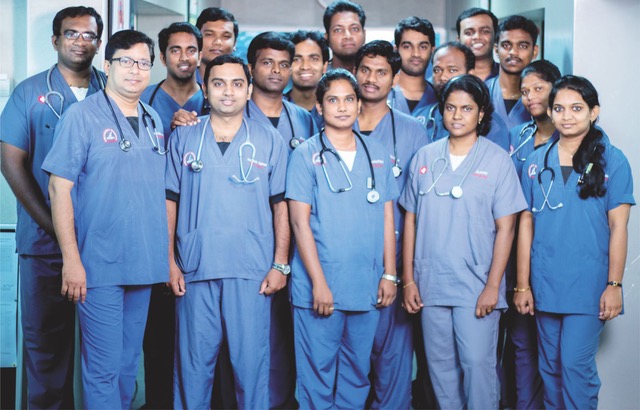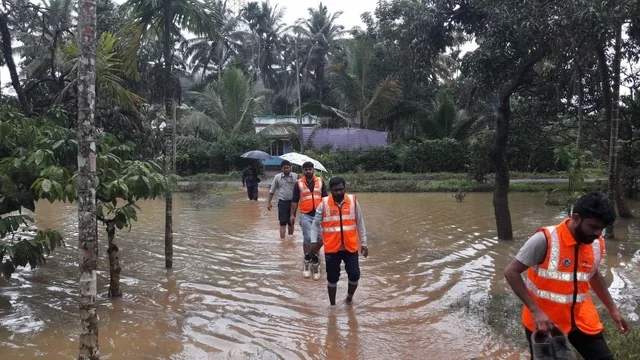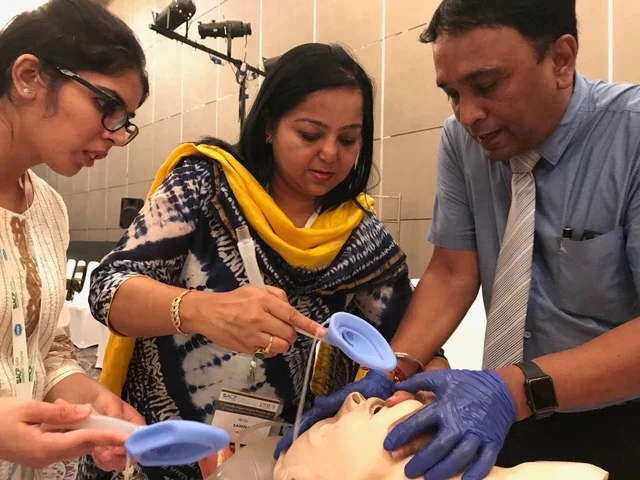In India, New EM Training Models Emerge to Meet Trauma Needs
by Dr. Kevin Davey, MD and Dr. Shweta Gidwani, MBBS, FRCEM
When Dr. Nerendra Nath Jena first became head of the Emergency/Casualty Department (ED) at Meenakshi Mission Hospital & Research Center (MMHRC) in 2008, there wasn’t much of a department for him to lead. Still a year before Emergency Medicine (EM) would become a formally recognized specialty in India [1], the department at that time consisted of only 5 beds, tucked into a 3 x 5 meter entry way leading to the ambulance bay outside. In those days the department had only 2 cardiac monitors, 2 ambulances and was staffed by 5 medical officers, none of whom, other than Dr. Jena, had any training in emergency medicine. Fast forward ten years and that same department now boasts 20 monitored beds staffed by 30 EM resident physicians, 6 ACLS capable ambulances served by 8 BLS/ACLS trained paramedics, 4 mechanical ventilators (3 adult, 1 pediatric), a bedside ultrasound machine and point of care x-ray and blood testing available 24 hours a day. The department has also become a leader in medical education, training emergency technicians, paramedics and physicians. In many ways the rise of the Emergency Department at MMHRC reflects the demand for improved access to emergency care across India.
The need for emergency medicine in India is immense. Injury is the second most common cause of death in India after age 5, second only to ischemic heart disease [2]. It is estimated that in 2016, 415 people died each day in India due to road traffic injuries, a staggering 32% increase in road traffic fatalities since 2007 [3]. Communicable disease still persists, and according to the World Health Organization, India is estimated to have 2.8 million new cases of tuberculosis per year, accounting for 27% of the global burden of disease [4]. Despite the vast need, much of the healthcare sector in India has been slow to adapt, particularly regarding the need for quality education and training programs.
Although emergency medicine was recognized in 2009 by the Medical Council of India, by 2018 through traditional training pathways like the DNB and MD programs, India is able to train only 194 emergency physicians per year [5,6,7]. This is woefully inadequate for a country with a population of 1.3 billion people. Using the United Kingdom and Singapore as comparisons, where there is roughly 1 EM physician for every 10,000 people, India would need to have approximately 132,000 practicing EM physicians to achieve similar proportions [8,9].
Dr. Jena (front row, far left) with last years graduating MEM class.
Faced with such staggering need and a paucity of officially sanctioned programs, some emergency departments in India have turned to alternative means of providing quality training. In 2010, two years after taking the reins at MMHRC, Dr. Jena partnered with George Washington University (GWU) and the Indian Medical Association College of General Practitioners (IMACGP) to provide the Post-Graduate Diploma in Emergency Medicine (PGDEM), a one training year program designed to allow practicing physicians to enhance their skills in emergency and trauma care. Four years later, in 2014, MMHRC partnered with GWU again, this time on the Master in Emergency Medicine (MEM) program, a 3-year residency training program in emergency medicine and acute care. The MEM program has rigorous requirements, including a 36 month modular curriculum, a thesis requirement, monthly exams, and formative assessments throughout the year culminating in a three day written and practical end of program exit exam. Local faculty teaching and supervision is augmented with monthly visits from international faculty who provide lectures on core EM curriculum and bedside teaching. Now four years into the program, MMHRC has graduated 20 EM physicians and has 30 current residents, supervised by 4 EM trained faculty.
Today the MMHRC Institute of Emergency Medicine sees an average of 18,000 patient visits per year, over double what it saw in 2008. In 2018 they received 700 ambulance calls serving a 200 mile radius. With an 80% admissions rate, half of which go to the ICU, the acuity in the department is extremely high and emergency physicians provide vital care for critically ill patients on a daily basis. Doctors at MMHRC have been recognized for their work in emergency medicine research and training. In 2017 and 2018 respectively, Drs. Arvinth Soundarajan and Rajalakshmi Chandran were invited to present their work on traumatic injuries and the role of point of care ultrasound in severity prediction for patients with dengue at the American College of Emergency Physicians (ACEP) academic assemblies in Washington D.C. and San Diego [10,11]. Dr. Jena has served as the National Secretary General for the Indian Society of Toxicology (2017-2018), the Society of Emergency Medicine in India (SEMI) (2016-2018), and was recently elected President of Emergency Physicians of India (EPI). He has been an invited speaker at emergency medicine conferences around the world, including the International Conference on Emergency Medicine (ICEM) in Hong Kong, Capetown, and Mexico, and most recently the European Society for Emergency Medicine (EUSEM) conference in Glasgow, Scotland in 2018.
The sign in front of Meenakshi Mission Hospital.
Understanding that delivering effective emergency care requires more than just well trained doctors, the MMHRC ED has also sought to improve training for emergency support staff and laypeople in the community. In 2011 in association with Dr. MGR Medical University, in Channai, Tamlinadu, MMHRC began offering three year training courses for emergency technicians and paramedics. In keeping with its mission to serve its community, in 2008 the MMHRC ED began providing first aid and BLS training to local college students and police departments. In January of 2019 MMH ED in coordination with the Society of Emergency Paramedics in India, organized the first International Emergency Paramedic conference (SEPICON19) in Madurai, India.
One of the cornerstones of the success of the MMHRC ED has been the continued support of the hospital leadership. MMHRC counts providing affordable, high quality care to all patients as part of its core mission. Through an unwavering commitment to education and training, the MMHRC administration has strongly supported the growth of EM at their institution.
The extraordinary efforts of the ED team at MMHRC have not gone unnoticed. In February, 2015 the MMHRC Institute of emergency medicine was formally dedicated by the former President of India Shri. Dr. A.P.J Abdul Kalam. “It was a long journey, and in this journey ‘casualty’ transformed to ‘Institute of Emergency Medicine,’” said Dr. Jena, reflecting on his time as Director and Head of the Institute of Emergency Medicine in MMHRC. While the road is long, and the need for quality emergency training in India is vast, the emergency physicians, nurses, and staff at MMHRC remain dedicated to providing the highest quality care for their patients. The MMHRC ED will continue to advocate for the development of emergency care, and promote high quality emergency training across India.
——
Shweta Gidwani, MBBS, MRCEM, FRCEM, graduated from Seth G.S. Medical College, Mumbai, India in 2002. She completed her core training in Emergency Medicine at Machester Royal Infirmary then moved to London where she completed her Fellowship in Emergency Medicine. She currently holds a Consultant appointment at Chelsea & Westminster NHS Foundation Trust, London where she works full time in the National Health Service (NHS). She has been involved in the development of emergency care service delivery and training programs in India for seven years.
——
1) Jain,M, B Batra, E Clark, T Kole. Development of Post-graduate program in emergency medicine in India: Current status, scope, and career pathways. Medical Education: New Frontiers. 2014; 1 (3), 218 – 221.
2) WHO India Country Cooperation Strategy. Accessed at http://apps.who.int/iris/bitstream/handle/10665/13689 5/ ccsbrief_ind_en.pdf;jsessionid=A307351DCB9210 9402D0D6ACC171B21D?sequence=1 on 10/11/2018.
3) Road Crash Statistics 2016. Analysis of Transport Research Wing, Ministry of Road Transport and Highways Data 2016. Accessed at http:// savelifefoundation.org/wp- content/uploads/2017/10/Traffic-Research-Wing- Data2016_Analysis_SLF.pdf on 10/11/2018. Emergency Medicine 4 Emergency Medicine February 18, 2019
4) India: WHO statistical profile. Accessed at http://www.who.int/gho/countries/ind.pdf?ua=1 on 10/11/2018.
5) Medical Council of India 2010. MD emergency medicine. Available at: http://www.mciindia.org/InformationDesk/CollegesCoursesSearch.aspx? N=235. Accessed 11/19/2018.
6) Indicative Seat Matrix – DNB PDCET January 2018 Admission Session. Accessed at https://www.natboard.edu.in/pdoof/pbnotice2018/cns / DNB%20PDCET%20Indicative%20Seat%20Matrix %20Jan%202018%20-%2028.03.2018.pdf?h88233er hx90wsd0q2wk2s2ks2 10/11/2018.
7) National Board of Examinations Counseling and Registration website, available at https://www.cns.natboard.edu.in/CandRv1/seatMatri x/ view_seats.php?transid=cFpWb1FqczlRSUh5MTR hN0xETFBKZz09accessed on 10/11/2018.
8) NHS Key Statistics England May 2018 House of Commons Library Briefing Paper Number 7281, 21 May 2018 Accessed at https:// researchbriefings.parliament.uk/ResearchBrief ing/Summary/CBP-7281 on 10/11/2018.
9) Pek, Jen Heng, et al. “Emergency Medicine as a Specialty in Asia.” Acute Medicine & Surgery, vol. 3, no. 2, 2015, pp. 65–73., doi:10.1002/ ams2.154.
10) A. Soundarrajan, N.N. Jena, J Smith, K. Douglas. A Retrospective Observational Study on Epidemiology of Traumatic Injuries Presenting to a Tertiary Care Hospital in Madurai, India. Oct 2017;70(4), S66.
11) R. Chandran, N.N. Jena, J Smith, K Douglas. A Prospective Observational Study on Role of Point of Care Ultrasound in Early Prediction of Severity of Dengue Infection Compared to Serological Tests in Patients Presenting to a Tertiary Care Center in India. Oct 2018;72(4), S86-87.








